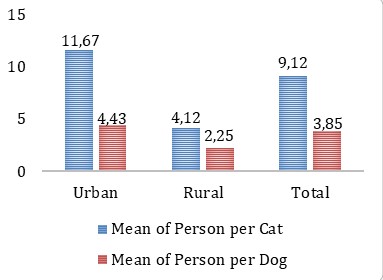Characteristics of the population of dogs and cats in Brazil
DOI:
https://doi.org/10.21708/avb.2019.13.2.8028Abstract
The precise estimation of the domestic animal population is important for effective health planning. The objective was to verify the applicability in Brazil of the method proposed by the World Health Organization (WHO), to estimate the animal population of developing countries, comparing it with data published by the Brazilian Institute of Geography and Statistics (IBGE). From the questionnaire prepared by IBGE, specific questions were selected to be submitted for statistical evaluation. The results indicate a population larger than that estimated by the WHO, there is still a low vaccination coverage, and campaigns should be intensified in cats and in rural areas. Rural areas have larger numbers of cats and dogs per household, and the concentration of animals in the cities is higher in neighborhoods consisting of houses than apartments. The dog is the companion animal of choice of Brazilians.
Downloads

Downloads
Pubblicato
Fascicolo
Sezione
Licenza
Autores que publicam na Acta Veterinaria Brasilica concordam com os seguintes termos: a) Autores mantém os direitos autorais e concedem à revista o direito de primeira publicação, com o trabalho simultaneamente licenciado sob a Licença Creative Commons Attribution que permite o compartilhamento do trabalho com reconhecimento da autoria e publicação inicial nesta revista. b) Autores têm autorização para assumir contratos adicionais separadamente, para distribuição não-exclusiva da versão do trabalho publicada nesta revista (ex.: publicar em repositório institucional ou como capítulo de livro), com reconhecimento de autoria e publicação inicial nesta revista. c) Autores têm permissão e são estimulados a publicar e distribuir seu trabalho online (ex.: em repositórios institucionais ou na sua página pessoal) a qualquer ponto antes ou durante o processo editorial, já que isso pode gerar alterações produtivas, bem como aumentar o impacto e a citação do trabalho publicado (Veja O Efeito do Acesso Livre).


 Esta obra está licenciada com uma Licença
Esta obra está licenciada com uma Licença 